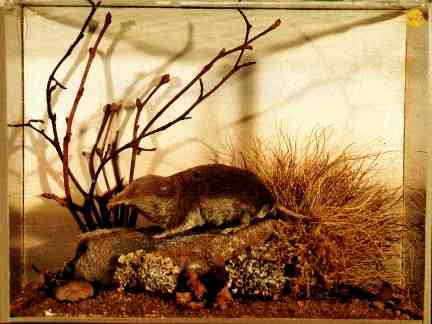
| Erinaceidae | Solenodontidae | Soricidae | Talpidae | Tenrecidae | |
Family: Soricidae (shrews)
There are over 300 species of shrews in 23 genera, making the Soricidae the largest family of lipotyphlans in terms of species number. Its members can be found throughout the world, except for the polar regions, Australia, and southern South America. Shrews possess characteristically long, pointed noses, which aid olfaction as well as burrowing into the ground as they forage for invertebrates. Although they possess small external ears, hearing and olfaction are acute. The skulls of shrews are long and narrow, usually with a flat profile. They lack zygomatic arches, auditory bullae, and postorbital processes. The dental formula is: i3/1-2, c1/0-1, pm1-3/1, m3/3 = 26 - 32. The first incisor is large and is made up of two very distinct cusps. The anterior cusp is elongate and projecting, resulting in the second being often mistaken for an additional tooth. The canines and pre-molars are small and peg-like. The upper molars are dilambdodont. Shrews lose their milk teeth before birth, and therefore tooth wear can become a problem in adult life. Older adults may starve to death when their teeth become too worn to function.
Shrews are notoriously small, (the pygmy white-toothed shrew is the smallest extant mammal weighing a mere 2-3 grams at adult weight). Their small size dictates a high metabolic rate, thus requiring an almost constant input of food items. Shrews are therefore cathemeral and have a voracious appetite, feeding primarily on invertebrates. Some shrews possess toxins in their saliva that allow them to hunt and kill larger prey, including small vertebrates, (such as frogs). The skin glands of many species contain similar toxins that are exuded as secretions when threatened, rendering them unpalatable to many carnivores. Soricids are typically terrestrial, though some are aquatic. The Tibetan water shrew (Genus Nectogale) is the only species with webbed feet, although other aquatic species, for example the European water shrew (Genus Neomys), have feet, toes, fingers and tail fringed with stiff hairs. These hairs increase surface area and aid propulsion.
The offspring of the genera Crocidura and Suncus exhibit an unusual feature known as 'caravanning', in which they grip the rump of the sibling in front while the leading sibling grips the rump of the parent. The parent then leads the offspring around the terrain of their habitat. (The grip is strong, and the whole caravan may be lifted off the ground intact by picking up the mother).

Neomys fodiens (European Water Shrew)






